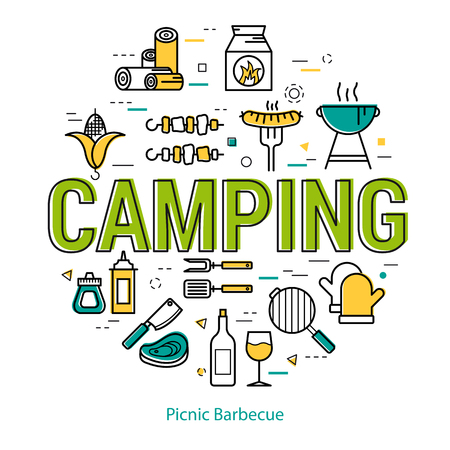1. Pre-Trip Meal Planning
One of the easiest ways to reduce food waste while camping is to plan your meals ahead of time. By organizing what you’ll eat for each day, you can avoid overpacking and make sure nothing goes to waste. Here’s how to do it right:
Plan Each Meal Before You Go
Start by writing down each meal for every day of your trip—breakfast, lunch, dinner, and snacks. This helps you pack only what you need and prevents bringing extra food that may spoil or go unused.
Sample 3-Day Camping Meal Plan
| Day | Breakfast | Lunch | Dinner | Snacks |
|---|---|---|---|---|
| Day 1 | Oatmeal with dried fruit | Turkey sandwiches | Grilled hot dogs and baked beans | Trail mix, granola bars |
| Day 2 | Pancakes & syrup (pre-mixed batter) | Wraps with tuna salad | Campfire chili with cornbread | Beef jerky, fruit cups |
| Day 3 | Smoothies (frozen fruit blend) | Leftover chili burritos | Pasta with canned marinara & veggies | Nuts, crackers with cheese spread |
Select Foods That Store Well
Choose ingredients that don’t spoil easily or require refrigeration. Non-perishable items like canned goods, dried fruits, rice, pasta, and nut butters are perfect for camping. If you’re bringing perishables like meat or dairy, be sure to store them in a quality cooler with plenty of ice packs.
Pre-Portion Ingredients at Home
Avoid bringing full containers of spices or large amounts of any one ingredient. Instead, portion out exactly what you need into reusable containers or zip-top bags. Label them so they’re easy to grab when cooking at camp. This not only saves space but also reduces the chance of food going unused.
Example: Ingredient Prep for Chili Night
- Canned beans (2 cans)
- Canned diced tomatoes (1 can)
- Pre-measured chili seasoning mix (in small container)
- Diced onions and peppers (chopped and stored in sealed bag)
- Ground beef (frozen and packed in cooler)
By thinking ahead about your meals, portioning ingredients properly, and selecting foods that last longer without refrigeration, you’ll cut down on waste and make your camping trip easier and more enjoyable.
2. Efficient Food Packing and Storage
Smart food packing not only saves space and keeps your meals fresh, but it also helps reduce waste and keeps wildlife safe. When youre out camping, especially in national parks or backcountry areas, proper food storage is essential for safety and environmental responsibility.
Use Coolers Wisely
Coolers are a must-have for most campers, but they need to be packed efficiently to keep food cold longer and avoid spoilage:
- Pre-chill your cooler: Add ice packs or frozen water bottles the night before your trip.
- Separate coolers: Use one for drinks (frequently opened) and another for perishable food.
- Layer smartly: Place raw meat at the bottom in leak-proof bags, then layer other items above.
- Keep it closed: Minimize opening time to maintain internal temperature.
Pack with Reusable Containers
Using reusable containers helps reduce single-use plastic waste and keeps your food organized:
- Label everything: Mark containers with meal names or days to simplify cooking plans.
- Airtight seals: Prevents spills and keeps bugs out.
- Nesting containers: Save space when not in use.
Follow Campsite Storage Rules
Depending on where youre camping, different rules may apply for storing food due to wildlife activity—especially bears. Always check local regulations ahead of time.
| Campsite Type | Recommended Storage Method | Why It Matters |
|---|---|---|
| Developed Campgrounds (with amenities) | Coolers + Car Storage (if allowed) | Keeps food secure from animals like raccoons and squirrels |
| Backcountry / Bear Country | Bear canisters or bear lockers | Essential for preventing bear encounters and fines |
| RV Sites with Hookups | Fridge inside RV + sealed bins outside | Easier storage, but still follow wildlife safety rules |
Bonus Tips for Smarter Packing
- Create a meal plan: Helps you pack only what you need and reduces leftovers.
- Avoid bulky packaging: Repack items into smaller, stackable containers before your trip.
- Bring extra zip-top bags or silicone pouches: Great for leftovers or separating trash later.
Packing efficiently makes your camping experience smoother while helping protect nature and reduce waste on your adventures.

3. Cooking Smart at the Campsite
One of the best ways to manage food waste while camping is by cooking smart. This means making just the right amount of food, finding creative ways to use leftovers, and minimizing food scraps during meal prep.
Cook Only What You Need
Before you start cooking, take a moment to plan your portions. Think about how hungry everyone usually is after a day outdoors. Heres a quick guide to help you estimate serving sizes:
| Food Type | Serving Size Per Adult |
|---|---|
| Pasta or Rice | 1 cup cooked (about 1/2 cup dry) |
| Meat or Protein | 4-6 oz |
| Vegetables | 1 cup cooked or raw |
| Bread or Tortillas | 1-2 pieces |
If youre not sure, its better to slightly undercook and supplement with easy snacks like granola bars or trail mix.
Get Creative with Leftovers
Leftovers don’t have to be boring. With a little creativity, yesterday’s dinner can become today’s breakfast or lunch. Here are some ideas:
- Taco Night Extras: Turn leftover grilled veggies and meat into a hearty breakfast scramble.
- Pasta: Reheat with some cheese and spices for a quick campfire mac & cheese.
- Burgers: Crumble and add to eggs or wrap in a tortilla for an easy burrito.
Reduce Prep Waste On-Site
Avoid bringing unnecessary packaging and do as much chopping and prepping at home as possible. Pre-cut veggies, marinated meats, and portioned ingredients save time and reduce trash at your campsite. Use reusable containers instead of plastic bags whenever possible.
Tips for Reducing Scraps While Cooking Outdoors:
- Use it all: Keep veggie peels to make a simple broth if youre staying multiple days.
- Simplify meals: Stick to one-pot recipes that require fewer ingredients and less prep work.
- Cook together: Involve everyone in prep so you can use up ingredients efficiently.
The more mindful you are while cooking, the less waste youll have to deal with later—and that makes cleanup easier too!
4. Waste Management and Disposal
When youre out camping, managing food waste the right way is super important—not just to keep your campsite clean, but also to protect wildlife and preserve nature for others. Heres how you can properly sort, store, and dispose of food waste while following Leave No Trace principles.
Sorting Food Waste
The first step in managing waste is knowing what kind of waste you’re dealing with. Heres a simple guide:
| Type of Waste | Examples | What to Do |
|---|---|---|
| Compostable | Fruit peels, veggie scraps, coffee grounds | Pack it out or compost if facilities allow |
| Trash | Plastic wrappers, foil, chip bags | Seal in a bag and pack it out |
| Recyclables | Cans, bottles, cardboard | Rinse and pack out for recycling later |
Storing Food Waste Safely
Never leave food scraps lying around your campsite. Store all food waste securely to avoid attracting animals. Use odor-proof bags or bear-proof containers when required by local regulations. Keep trash and food waste stored at least 200 feet away from sleeping areas if possible.
Disposing of Food Waste Properly
- Pack It Out: In most cases, the best option is to bring all your food waste back home. Bring extra zip-top bags or designated trash bags for this purpose.
- Burying Is Not Recommended: Burying food scraps may attract animals and isn’t consistent with Leave No Trace practices.
- Use Designated Bins: If youre at a developed campsite, use the provided trash and recycling bins correctly.
Composting While Camping
If youre camping in an area that supports composting (some organized campsites might), you can separate compostables like fruit and veggie scraps. However, always check local rules—composting isnt allowed everywhere.
Quick Composting Tips:
- Avoid composting meat, dairy, or oily foods—they attract wildlife.
- If there’s no compost bin on-site, pack it out in a sealed container.
Leave No Trace Practices
The Leave No Trace principle “Dispose of Waste Properly” reminds us to minimize our impact. That means packing out everything you bring in—including all food-related waste. Even biodegradable items like orange peels or sunflower seed shells take time to break down and don’t belong on the ground.
5. Cleaning Up and Minimizing Impact
Keeping your campsite clean isn’t just about looks—it’s essential for protecting wildlife, staying safe, and preserving the outdoors for everyone. After meals, cleaning up properly and storing waste securely helps prevent animals from being attracted to your site.
Best Practices for Cleaning Cookware
After cooking and eating, wash all cookware as soon as possible. Leftover food particles and grease can attract bears, raccoons, and other wildlife. Here’s a simple process you can follow:
| Step | Action |
|---|---|
| 1. Scrape Off Food | Use a spatula or paper towel to remove all leftover food into your trash bag. |
| 2. Use Biodegradable Soap | Wash dishes with biodegradable soap at least 200 feet away from any water source. |
| 3. Rinse Thoroughly | Rinse with clean water and be sure no soap residue remains. |
| 4. Strain Greywater | Pour used water through a strainer to catch food bits, then pack those out with your trash. |
| 5. Scatter Water | Spread strained greywater over a wide area away from camp trails or tents. |
Storing Waste Securely Overnight
No matter how remote your campsite is, animals have an incredible sense of smell. Always secure food scraps, wrappers, and even scented items like toothpaste or sunscreen.
Safe Storage Options:
- Bear-Resistant Canisters: These hard-sided containers are required in many national parks and are great for keeping smells contained.
- Hang Bags Properly: If you’re in bear country without a canister, hang food bags at least 10-12 feet off the ground and 4-6 feet away from tree trunks.
- Lockable Bins or Coolers: In car camping areas, use lockable coolers or designated food storage lockers provided at campsites.
Tidy Campsite = Safer Wilderness
A clean campsite discourages unwanted animal visitors and keeps nature pristine for others. Before heading to bed or leaving camp, do a quick sweep for crumbs, wrappers, and other trash. Pack it out—even if it’s something small like a fruit peel or tea bag. When everyone does their part, our wild places stay wild—and welcoming—for years to come.


